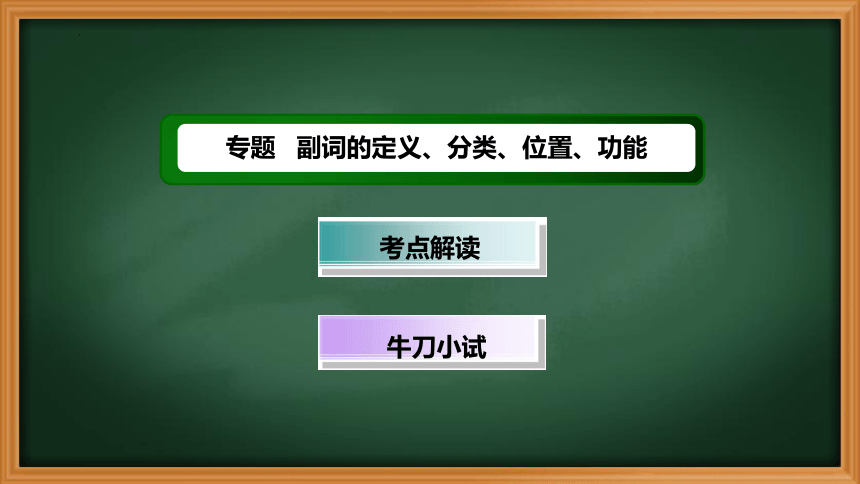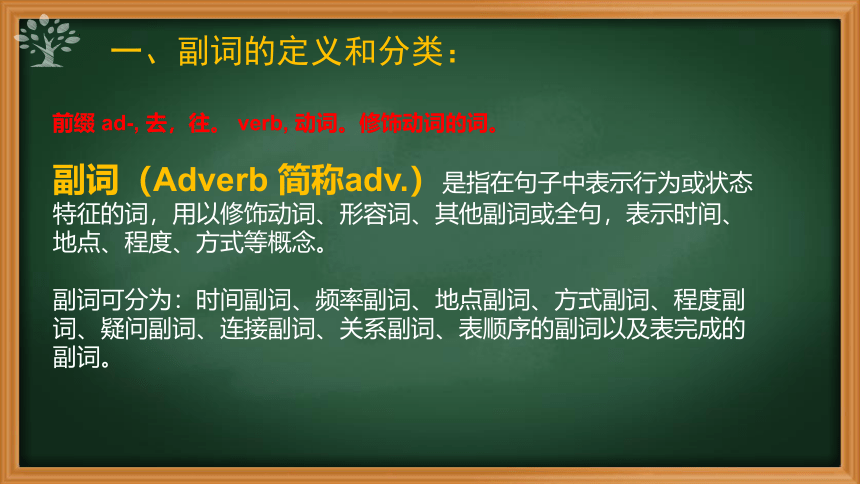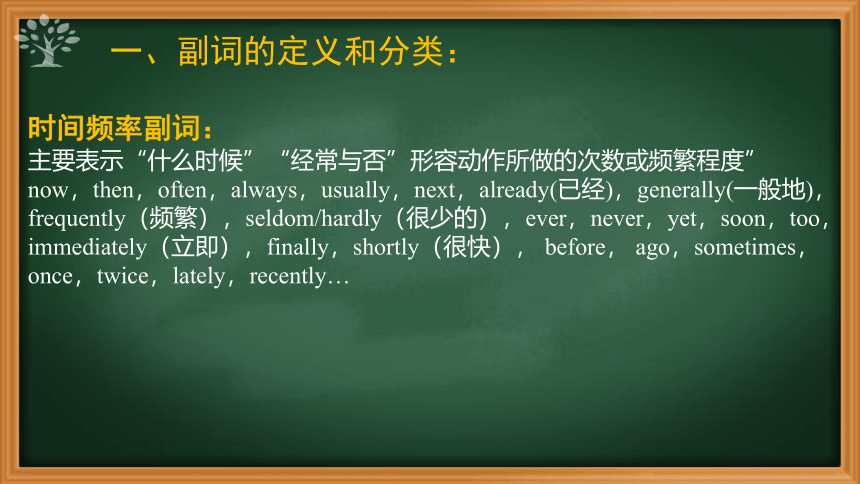2022届高三英语二轮复习副词的定义、分类、位置、功能课件(27张)
文档属性
| 名称 | 2022届高三英语二轮复习副词的定义、分类、位置、功能课件(27张) |  | |
| 格式 | zip | ||
| 文件大小 | 803.7KB | ||
| 资源类型 | 教案 | ||
| 版本资源 | 人教版(2019) | ||
| 科目 | 英语 | ||
| 更新时间 | 2022-04-17 10:34:28 | ||
图片预览









文档简介
(共27张PPT)
考点解读
牛刀小试
专题 副词的定义、分类、位置、功能
一、副词的定义和分类
二、副词的句法功能
三、副词的位置
学习目标:
一、副词的定义和分类:
副词(Adverb 简称adv.)是指在句子中表示行为或状态特征的词,用以修饰动词、形容词、其他副词或全句,表示时间、地点、程度、方式等概念。
副词可分为:时间副词、频率副词、地点副词、方式副词、程度副词、疑问副词、连接副词、关系副词、表顺序的副词以及表完成的副词。
前缀 ad-, 去,往。 verb, 动词。修饰动词的词。
一、副词的定义和分类:
时间频率副词:
主要表示“什么时候”“经常与否”形容动作所做的次数或频繁程度”
now,then,often,always,usually,next,already(已经),generally(一般地),frequently(频繁),seldom/hardly(很少的),ever,never,yet,soon,too, immediately(立即),finally,shortly(很快), before, ago,sometimes, once,twice,lately,recently…
一、副词的定义和分类:
地点副词:
表示地点与位置关系的副词,用来说明动作是在什么地方发生的。
here, there, everywhere, anywhere,somewhere, in, out, inside,
outside,above, below, up,down, back, forward(向前的), home,
upstairs(楼上的), downstairs, across, along, round , around,
near, off, past, up, away, on…
一、副词的定义和分类:
方式副词:
carefully, properly(适当地), anxiously(焦虑地), suddenly, normally(正常地),fast, well, calmly(冷静地), politely(有礼貌地), proudly(自豪地), softly,warmly ,slowly,badly,hard,bravely…
一、副词的定义和分类:
程度副词
much,little, very,rather(相当),so,too,still, quite, perfectly(完美地),enough, extremely(非常), entirely(整个),almost, slightly(细小地), hardly.…
一、副词的定义和分类:
疑问副词:
how, when, where, why…
关系副词:
when, where, why…
连接副词:
therefore(因此),moreover(此外),however,otherwise(另外的),
then,when ,where,how,why…
表顺序的副词:
first,then,next,finally,afterwards,primarily…
一、副词的定义和分类:
完成时的副词:
already,ever,just,never,since,yet,recently…
副词在句中可作状语,表语,补语,定语,宾语。
二、副词的句法功能
She quietly left the room. 她悄悄的离开了房间。
I think boiling differently. 我有不同的想法。
You speak English very well. 你英语讲的非常好。
The weather is freezing cold. 天气冷极了。
Look at the photo carefully. 仔细看看这张照片。
二、形容词的句法功能—作状语
二、形容词的句法功能—作表语
The meeting is over. 会议结束了。
Is anyone upstairs 楼上有人吗?
Is the radio on or off 收音机是开着的还是关着的?
Does she stay home (作表语)她呆在家吗
★在通常情况下,用作表语时不用副词而用形容词,如可说The woman is beautiful. 而不说 The woman is beautifully. 可说The cloth feels soft. 不能说 The cloth feels softly. 英语中用作表语的副词主要是表地点的副词以及某些与介词同形的副词,而且只能用于连系动词be 后作表语,而不用于其他连系动词后作表语,如可说He is here 或 He is abroad,但不能说He seems here 或 He seems abroad。
It’s not far from here. 从这儿去不远。
二、形容词的句法功能—作宾语
★副词用作宾语的用法十分有限,通常只用作介词宾语,并且只限于某些表示时间和地点的副词,而且不同的副词有不同的搭配特点,如 here和there 可与along, around, down, from, in, near, round, up 等介词连用,但通常不与介词to连用,如不说come to here, go to there 等(注:from here to there是例外),而表地点的副词abroad 则只与介词from连用,不与其他介词连用。
Let him out! 让他出去!
Ask him in, please. 请叫他进来。
We must try to help him through. 我们必须设法帮他渡过难关。
★一般说来,能用作表语的副词都可用作宾语补足语:
He went to see her but found that she was out. 他去看她,但发现她不在家。
He went to see her but found her out. 他去看她,但发现她不在家。
二、形容词的句法功能—作宾语补足语
The people there were very friendly. 那儿的人很友好。
Do you know the people downstairs 你认识楼下的人吗?
The shops around are very cheap. 附近商店的东西很便宜。
二、形容词的句法功能—作定语
★在通常情况下,副词用作定语总是放在被修饰名词之后,若置于修饰名词之前,则通常被视为形容词,如the upstairs room和the room upstairs 都表示“楼上的房间”,但前者的upstairs 前置,为形容词;后者的upstairs后置,为副词;又如the above passage 和the passage above都可表示“上面的段落”,但前者的above 前置,为形容词;后者的above后置,为副词。
1.副词可以修饰动词,包括不定词、动名词和分词,通常位于被修饰的动词后面;修饰及物动词时,一般放在宾语的后面。
三、副词的位置
They walked slowly. 他们走得很慢。
We saw a boat coming quickly toward us. 我们看到小船很快地朝我们驶来。
三、副词的位置
2.副词修饰动词,放在句首时,起强调的作用。
Quickly, he stood up to catch the butterfly. 他飞快地站起来去捉蝴蝶。
3.肯定否定副词或频率副词多置于一般动词之前,但通常要放在助动词、联系动词Be之后。
He never spoke about his own merits. 他从不说起他自己的功绩。
We may never see him again. 我们也许再也见不到他。
He is often late for school. 他常上学迟到。
三、副词的位置
4.修饰形容词的副词通常放在该形容词的前面。
This is a very funny film.这是一部非常有趣的电影。
This room is fairly small.这个房间相当小。
★副词enough修饰形容词时,要放在被修饰的形容词之后。
This kitchen is not big enough.这个厨房不够大。
The number of the money is big enough.钱的数目足够大了。
三、副词的位置
5. 副词在修饰其他副词时,置于被修饰副词之前。
He drives extremely fast.他车开得非常快。(副词extremely修饰副词fast)
Do it right now.马上就做。(副词right修饰副词now)
He didn‘t run fast enough to catch the thief.他跑得不够快没能追上那个贼。
(副词enough, indeed等在修饰副词时,置于被修饰副词之后)
三、副词的位置
6. 副词修饰基数词时,一般置于被修饰的数词之前。
They are going to stay here fully six months.他们将要在这里停留整六个月。
(副词fully修饰基数词six)
This car cost me over ten thousand dollars.这辆车花掉了我一万多美元。
(副词over修饰基数词ten thousand )
三、副词的位置
7. 副词修饰介系词片语,一般置于被修饰的介系词片语之前。
This long nail went right through the plank. 这根长钉子完全穿透了木板。
(副词right修饰介系词片语through the wall)
She made her application well within the term.她正好在这段期间内提出申请。
(副词well修饰介系词片语within the term )
8.副词修饰子句时,一般放在被修饰的子句之前。
There was a knock at the door just as we were about to have dinner.
我们正要吃晚饭的时候有人敲门。(just修饰副词子句as we were about to…)
副词也可以修饰整个句子,通常位于句首,若置于句尾可能被认为是修饰动词造成语意的偏差。
Happily he went with them. 他高兴地跟他们走了。(happily修饰全句)
修饰全句的副词置于句中或句末时必须用逗点隔开,如无逗点隔开易被认为是修饰动词,而放在句首时则逗点可有可无。
He escaped being killed in the car accident, fortunately.很幸运他没在车祸中丧命。
三、副词的位置
三、副词的位置
1.少数副词可以修饰名词及名词同等语,通常放在被修饰名词的前面。
also, very, even, just, only, not, nearly, especially, exactly, simply, rather, quite等。
Even a child can do it. 甚至小孩也能做到。(even修饰名词片语a child)
Only she could come.只有她能来。(副词only修饰代名词she)
2.某些副词要置于被修饰的名词之后。
I met her the week before. 上星期我见过她。(副词before修饰名词week)
See the notes below. 参考下面的注解。(副词below修饰名词notes)
He, too, loves her. 他也爱她。(too修饰he,要放在he之后)
三、副词的位置—排列顺序
1. 当方式副词、地点副词、时间副词等用在一起时,通常按“方式副词→地点副词→时间副词”的规律排列。
The boy read quietly over there all afternoon. 这男孩整个下午都在那儿静静地看书。
★但是,对于run / go / drive / move / walk / head / leave 等表示位置移动词的动词,修饰它们的多个副词通常按“地点副词→方式副词→时间副词”的规律排列。如:
He went there happily yesterday. 他昨天高兴地去了那儿。
2.在句子中若有多个时间副词,要从短时间到长时间排列。
He woke up at six in the morning on the fifth of October.
他在十月五日早上六点醒来。
I broke my legs in the evening on the fifth of October last year.
去年十月五日的晚上我摔断了双腿。
三、副词的位置—排列顺序
三、副词的位置—排列顺序
3.在句子中若有多个地方副词,要从小地方到大地方排列。
I met him at a bar in a small town in New York State.
我在纽约州的一座小镇的酒吧里遇到了他。
I met a beggar at the gate of a park in a small town in London one day.
一天我在伦敦一座小镇的公园门口遇到一个乞丐。
温
示
提
馨
本节结束,谢谢观看!
考点解读
牛刀小试
专题 副词的定义、分类、位置、功能
一、副词的定义和分类
二、副词的句法功能
三、副词的位置
学习目标:
一、副词的定义和分类:
副词(Adverb 简称adv.)是指在句子中表示行为或状态特征的词,用以修饰动词、形容词、其他副词或全句,表示时间、地点、程度、方式等概念。
副词可分为:时间副词、频率副词、地点副词、方式副词、程度副词、疑问副词、连接副词、关系副词、表顺序的副词以及表完成的副词。
前缀 ad-, 去,往。 verb, 动词。修饰动词的词。
一、副词的定义和分类:
时间频率副词:
主要表示“什么时候”“经常与否”形容动作所做的次数或频繁程度”
now,then,often,always,usually,next,already(已经),generally(一般地),frequently(频繁),seldom/hardly(很少的),ever,never,yet,soon,too, immediately(立即),finally,shortly(很快), before, ago,sometimes, once,twice,lately,recently…
一、副词的定义和分类:
地点副词:
表示地点与位置关系的副词,用来说明动作是在什么地方发生的。
here, there, everywhere, anywhere,somewhere, in, out, inside,
outside,above, below, up,down, back, forward(向前的), home,
upstairs(楼上的), downstairs, across, along, round , around,
near, off, past, up, away, on…
一、副词的定义和分类:
方式副词:
carefully, properly(适当地), anxiously(焦虑地), suddenly, normally(正常地),fast, well, calmly(冷静地), politely(有礼貌地), proudly(自豪地), softly,warmly ,slowly,badly,hard,bravely…
一、副词的定义和分类:
程度副词
much,little, very,rather(相当),so,too,still, quite, perfectly(完美地),enough, extremely(非常), entirely(整个),almost, slightly(细小地), hardly.…
一、副词的定义和分类:
疑问副词:
how, when, where, why…
关系副词:
when, where, why…
连接副词:
therefore(因此),moreover(此外),however,otherwise(另外的),
then,when ,where,how,why…
表顺序的副词:
first,then,next,finally,afterwards,primarily…
一、副词的定义和分类:
完成时的副词:
already,ever,just,never,since,yet,recently…
副词在句中可作状语,表语,补语,定语,宾语。
二、副词的句法功能
She quietly left the room. 她悄悄的离开了房间。
I think boiling differently. 我有不同的想法。
You speak English very well. 你英语讲的非常好。
The weather is freezing cold. 天气冷极了。
Look at the photo carefully. 仔细看看这张照片。
二、形容词的句法功能—作状语
二、形容词的句法功能—作表语
The meeting is over. 会议结束了。
Is anyone upstairs 楼上有人吗?
Is the radio on or off 收音机是开着的还是关着的?
Does she stay home (作表语)她呆在家吗
★在通常情况下,用作表语时不用副词而用形容词,如可说The woman is beautiful. 而不说 The woman is beautifully. 可说The cloth feels soft. 不能说 The cloth feels softly. 英语中用作表语的副词主要是表地点的副词以及某些与介词同形的副词,而且只能用于连系动词be 后作表语,而不用于其他连系动词后作表语,如可说He is here 或 He is abroad,但不能说He seems here 或 He seems abroad。
It’s not far from here. 从这儿去不远。
二、形容词的句法功能—作宾语
★副词用作宾语的用法十分有限,通常只用作介词宾语,并且只限于某些表示时间和地点的副词,而且不同的副词有不同的搭配特点,如 here和there 可与along, around, down, from, in, near, round, up 等介词连用,但通常不与介词to连用,如不说come to here, go to there 等(注:from here to there是例外),而表地点的副词abroad 则只与介词from连用,不与其他介词连用。
Let him out! 让他出去!
Ask him in, please. 请叫他进来。
We must try to help him through. 我们必须设法帮他渡过难关。
★一般说来,能用作表语的副词都可用作宾语补足语:
He went to see her but found that she was out. 他去看她,但发现她不在家。
He went to see her but found her out. 他去看她,但发现她不在家。
二、形容词的句法功能—作宾语补足语
The people there were very friendly. 那儿的人很友好。
Do you know the people downstairs 你认识楼下的人吗?
The shops around are very cheap. 附近商店的东西很便宜。
二、形容词的句法功能—作定语
★在通常情况下,副词用作定语总是放在被修饰名词之后,若置于修饰名词之前,则通常被视为形容词,如the upstairs room和the room upstairs 都表示“楼上的房间”,但前者的upstairs 前置,为形容词;后者的upstairs后置,为副词;又如the above passage 和the passage above都可表示“上面的段落”,但前者的above 前置,为形容词;后者的above后置,为副词。
1.副词可以修饰动词,包括不定词、动名词和分词,通常位于被修饰的动词后面;修饰及物动词时,一般放在宾语的后面。
三、副词的位置
They walked slowly. 他们走得很慢。
We saw a boat coming quickly toward us. 我们看到小船很快地朝我们驶来。
三、副词的位置
2.副词修饰动词,放在句首时,起强调的作用。
Quickly, he stood up to catch the butterfly. 他飞快地站起来去捉蝴蝶。
3.肯定否定副词或频率副词多置于一般动词之前,但通常要放在助动词、联系动词Be之后。
He never spoke about his own merits. 他从不说起他自己的功绩。
We may never see him again. 我们也许再也见不到他。
He is often late for school. 他常上学迟到。
三、副词的位置
4.修饰形容词的副词通常放在该形容词的前面。
This is a very funny film.这是一部非常有趣的电影。
This room is fairly small.这个房间相当小。
★副词enough修饰形容词时,要放在被修饰的形容词之后。
This kitchen is not big enough.这个厨房不够大。
The number of the money is big enough.钱的数目足够大了。
三、副词的位置
5. 副词在修饰其他副词时,置于被修饰副词之前。
He drives extremely fast.他车开得非常快。(副词extremely修饰副词fast)
Do it right now.马上就做。(副词right修饰副词now)
He didn‘t run fast enough to catch the thief.他跑得不够快没能追上那个贼。
(副词enough, indeed等在修饰副词时,置于被修饰副词之后)
三、副词的位置
6. 副词修饰基数词时,一般置于被修饰的数词之前。
They are going to stay here fully six months.他们将要在这里停留整六个月。
(副词fully修饰基数词six)
This car cost me over ten thousand dollars.这辆车花掉了我一万多美元。
(副词over修饰基数词ten thousand )
三、副词的位置
7. 副词修饰介系词片语,一般置于被修饰的介系词片语之前。
This long nail went right through the plank. 这根长钉子完全穿透了木板。
(副词right修饰介系词片语through the wall)
She made her application well within the term.她正好在这段期间内提出申请。
(副词well修饰介系词片语within the term )
8.副词修饰子句时,一般放在被修饰的子句之前。
There was a knock at the door just as we were about to have dinner.
我们正要吃晚饭的时候有人敲门。(just修饰副词子句as we were about to…)
副词也可以修饰整个句子,通常位于句首,若置于句尾可能被认为是修饰动词造成语意的偏差。
Happily he went with them. 他高兴地跟他们走了。(happily修饰全句)
修饰全句的副词置于句中或句末时必须用逗点隔开,如无逗点隔开易被认为是修饰动词,而放在句首时则逗点可有可无。
He escaped being killed in the car accident, fortunately.很幸运他没在车祸中丧命。
三、副词的位置
三、副词的位置
1.少数副词可以修饰名词及名词同等语,通常放在被修饰名词的前面。
also, very, even, just, only, not, nearly, especially, exactly, simply, rather, quite等。
Even a child can do it. 甚至小孩也能做到。(even修饰名词片语a child)
Only she could come.只有她能来。(副词only修饰代名词she)
2.某些副词要置于被修饰的名词之后。
I met her the week before. 上星期我见过她。(副词before修饰名词week)
See the notes below. 参考下面的注解。(副词below修饰名词notes)
He, too, loves her. 他也爱她。(too修饰he,要放在he之后)
三、副词的位置—排列顺序
1. 当方式副词、地点副词、时间副词等用在一起时,通常按“方式副词→地点副词→时间副词”的规律排列。
The boy read quietly over there all afternoon. 这男孩整个下午都在那儿静静地看书。
★但是,对于run / go / drive / move / walk / head / leave 等表示位置移动词的动词,修饰它们的多个副词通常按“地点副词→方式副词→时间副词”的规律排列。如:
He went there happily yesterday. 他昨天高兴地去了那儿。
2.在句子中若有多个时间副词,要从短时间到长时间排列。
He woke up at six in the morning on the fifth of October.
他在十月五日早上六点醒来。
I broke my legs in the evening on the fifth of October last year.
去年十月五日的晚上我摔断了双腿。
三、副词的位置—排列顺序
三、副词的位置—排列顺序
3.在句子中若有多个地方副词,要从小地方到大地方排列。
I met him at a bar in a small town in New York State.
我在纽约州的一座小镇的酒吧里遇到了他。
I met a beggar at the gate of a park in a small town in London one day.
一天我在伦敦一座小镇的公园门口遇到一个乞丐。
温
示
提
馨
本节结束,谢谢观看!
